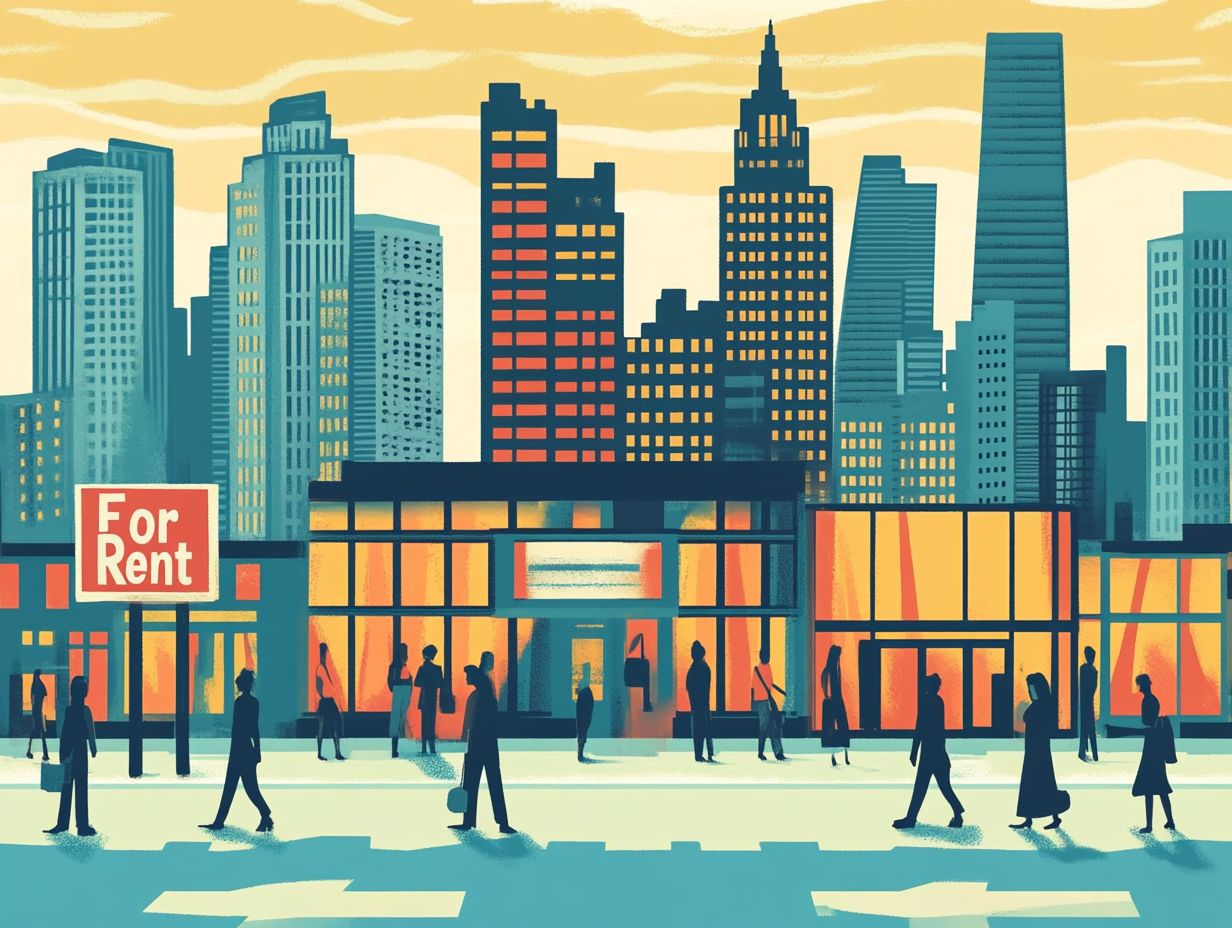The Connection Between Employment Rates and Housing
Understanding the connection between employment rates and housing is crucial in today’s economic landscape. Employment levels directly influence your ability to secure housing and can shape broader market trends.
This article looks at the effects of both low and high employment rates on housing, shining a light on pressing issues like rising homelessness and escalating housing costs.
It also discusses potential solutions, including innovative government policies and community initiatives, all aimed at fostering a more stable housing environment.
Dive in to explore how these factors intertwine and discover actionable steps that can be taken to address these challenges.
Contents
- Key Takeaways:
- How Jobs Affect Housing Costs
- Effects of Low Employment Rates on Housing
- Effects of High Employment Rates on Housing
- Solutions to Address the Connection
- Frequently Asked Questions
- What is the connection between employment rates and housing?
- How do employment rates impact the housing market?
- What are the consequences of low employment rates on the housing sector?
- How do fluctuations in employment rates affect the housing market?
- What role do employment rates play in the rental housing market?
- How can changes in employment rates affect the housing affordability crisis?
Key Takeaways:

Low employment rates can lead to rising homelessness and housing insecurity, making it difficult for individuals and families to secure stable housing.
High employment rates can result in inflation and rising housing costs, making it challenging for individuals with lower incomes to afford housing.
Government policies and community initiatives are crucial in addressing the connection between employment rates and housing, providing support and creating more affordable housing options.
How Jobs Affect Housing Costs
The impact of employment rates on housing is significant, as highlighted by various economic studies and the Economic Report from President Biden’s Council of Economic Advisers.
With full employment as a target, grasping how employment rates shape housing dynamics becomes essential, especially in the context of the current housing shortage and rising Black unemployment rates.
These factors intensify the hurdles faced by first-time homebuyers and low-income families in their pursuit of affordable housing options.
Overview of the Relationship
Understanding how jobs and housing costs are linked is very important. When employment fluctuates, it directly impacts mortgage costs and housing prices in the market.
As employment rates rise, household incomes typically increase as more individuals secure jobs. This leads to a heightened demand for housing and, consequently, driving up prices.
This scenario can create a paradox: as prices soar, many potential buyers find themselves priced out of the market, particularly first-time homeowners who may not have enough savings for a substantial down payment.
Rising mortgage costs, driven by increasing interest rates, intensify this dilemma and compel many to reassess their purchasing options.
As you navigate these financial hurdles, cycles of housing insecurity may emerge, straining not only your personal finances but also the broader economy.
Effects of Low Employment Rates on Housing
Low employment rates can spell serious trouble for housing stability, often resulting in a surge of homelessness and heightened housing insecurity.
This situation becomes particularly critical for low-income families who depend on public and affordable housing options to make ends meet.
Rising Homelessness and Housing Insecurity

Rising homelessness and housing insecurity are compounded by low employment rates, with marginalized communities bearing the brunt of the impact. This includes groups facing significant Black unemployment rates and limited access to affordable housing options.
These challenges are closely linked to broader socio-economic factors, such as systemic inequities in education, healthcare access, and wage disparities, which disproportionately affect these communities.
Without meaningful changes in policy and community support systems, many individuals find themselves ensnared in a relentless cycle of poverty.
We must act now just treating the symptoms of homelessness isn’t enough. True and effective solutions must confront the root causes, including the scarcity of affordable housing and the absence of job training programs.
Join us in pushing for real solutions that tackle these root causes and create lasting improvements in the lives of those who are affected.
Decrease in Housing Affordability
Housing affordability decreases when employment rates are low. Rising mortgage costs and stagnant wages create barriers for potential homebuyers, especially in low-income areas.
This trend results from several economic factors working together. Minimal job availability and high-interest rates intensify the struggle to secure loans.
Economic studies show a clear link between employment levels and mortgage rates. When job opportunities dwindle, achieving homeownership becomes more daunting for those with financial constraints.
Effects of High Employment Rates on Housing
High employment rates can enhance housing markets significantly. They alleviate inflation and stabilize housing costs.
As more individuals achieve financial stability, demand for housing increases, creating a robust market environment.
Inflation and Rising Housing Costs
While high employment can spur economic growth, it can also lead to increased prices, driving up housing costs. This creates a complex challenge for policymakers.
As businesses hire more workers, consumer spending surges, triggering higher prices across various sectors.
Economic research indicates that when wages rise in a tight labor market, the costs of goods and services, especially in housing, often follow suit.
Prospective homebuyers face soaring prices and limited inventory. Balancing inflationary pressures is crucial to keep homeownership dreams within reach.
Increase in Demand for Housing

An increase in housing demand often coincides with high employment. More individuals can enter the market as first-time homebuyers due to improved financial conditions and favorable mortgage rates.
This surge creates a lively housing market filled with opportunities for buyers, builders, and investors.
While first-time homebuyers may find it easier to secure loans, rising demand can unintentionally drive housing prices upward. This situation demands immediate action to maintain market balance.
A stable environment ensures that potential homeowners aren t priced out, fostering sustainable growth and community development.
Solutions to Address the Connection
To understand the connection between employment rates and housing stability, consider a comprehensive plan. This approach involves government policies and community initiatives that are vital for sustainable housing solutions.
Government Policies and Programs
Government initiatives, such as the Low-Income Housing Tax Credit and job training programs, enhance housing stability and tackle employment-related challenges. These aren t just about providing quick relief; they focus on fostering long-term sustainability.
For instance, the Low-Income Housing Tax Credit encourages the construction of affordable housing units, but it faces hurdles like limited funding and bureaucratic red tape.
Job training programs aim to equip individuals with essential skills, yet gaps in accessibility and outreach to underserved areas remain.
By assessing these programs and identifying areas for improvement, you can help create a more effective framework that ensures marginalized communities genuinely benefit.
Community Initiatives and Support
Community initiatives and support systems play a vital role in promoting housing stability. This is especially true for families in need of public and affordable housing options.
Take, for instance, the impressive collaboration between local non-profits and city governments. Programs like ‘Housing First’ have emerged from this partnership, prioritizing stable housing for families before addressing issues like employment or healthcare.
By offering comprehensive support services such as job training and financial literacy workshops these initiatives empower families to build a sustainable future. Local partnerships with businesses enrich these efforts by providing essential resources. This ensures families not only have a roof over their heads but also the skills needed to thrive in the long run.
Advocating for increased funding and policy reforms at the state level is crucial. This community support is urgent for families in need!
Frequently Asked Questions

What is the connection between employment rates and housing?
The connection between employment rates and housing refers to the relationship between the number of employed individuals and housing availability. This connection is important because employment is a key factor in a person’s ability to afford and maintain housing.
How do employment rates impact the housing market?
Employment rates significantly impact the housing market. When employment rates are high, demand for housing often increases, driving prices higher and making it tougher for families to find affordable options. Conversely, low employment rates can decrease demand, resulting in lower prices.
What are the consequences of low employment rates on the housing sector?
Low employment rates can have serious consequences on the housing sector. They may lead to decreased demand for housing and a drop in housing prices. This situation can also result in an increase in foreclosures, as people struggle to keep their homes without a steady income.
How do fluctuations in employment rates affect the housing market?
Fluctuations in employment rates can significantly influence the housing market. A sudden decrease in employment rates may lead to a drop in housing demand, resulting in lower prices. On the other hand, an increase in employment rates can boost demand and, consequently, prices.
What role do employment rates play in the rental housing market?
Employment rates are crucial in the rental housing market as well. When employment is high, individuals have stable incomes and can afford higher rent. In contrast, low employment rates may cause individuals to struggle with rent payments, leading to increased vacancies and potentially lower rental prices.
How can changes in employment rates affect the housing affordability crisis?
The connection between employment rates and housing affordability is closely linked. Low employment rates make it harder for individuals to find and maintain stable housing, contributing to the housing affordability crisis. Conversely, high employment rates provide more financial stability, improving the chances of affording housing.






